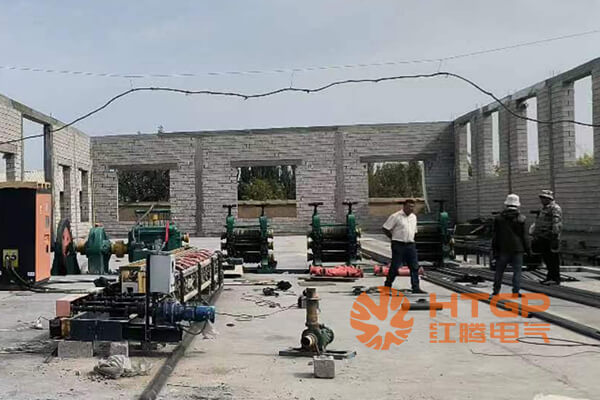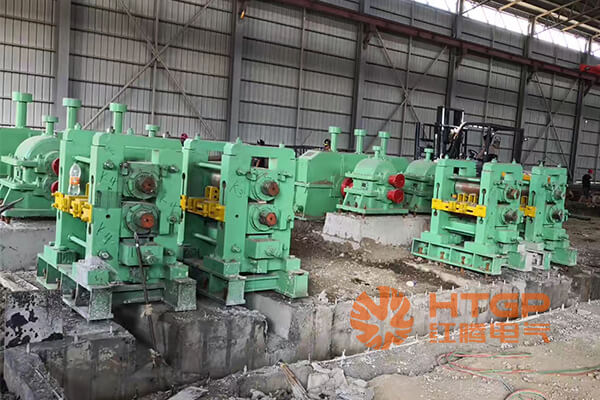Different Types of Steel Rolling Machines and Their Application Cases
A steel rolling machine is an important piece of industrial equipment used to process steel billets or other metal materials into steel products of various shapes and sizes. According to the rolling process and process requirements, the steel rolling machines can be divided into many types, each type has its specific applications.
Different Types of Steel Rolling Machines
Rough Steel Rolling Machine
This rolling mill uses steel ingots as raw material to provide raw materials for the finished rolling mill. It mainly includes square billet blooming mill, square billet blooming mill and slab blooming mill.
It is commonly found in the preliminary rolling workshops of steel complex enterprises and is used to produce steel billets of various specifications to provide sufficient raw materials for the subsequent rolling process.
Billet Rolling Mill
This kind of rolling mill is also a rolling mill that provides raw materials for the finished rolling mill, but its raw material is not steel ingots, but steel billets. Billet rolling mills are generally divided into two types: continuous and horizontal.
It is widely used in steel plate and section steel production lines to provide qualified semi-finished products for subsequent finished product rolling mills. It is widely used in construction, bridges, machinery manufacturing and other fields to provide solid support materials for various industrial structures.
Section Steel Rolling Machine
This type of rolling mill is mainly used to produce various steel sections, such as rail beams, large, medium and small rolling mills, and wire rod mills.
It is mainly used to produce hot-rolled steel plates, hot-rolled strip steel, etc., and is widely used in construction, automobile, shipbuilding, petrochemical and other industries.
Hot-rolled Plate and Strip Rolling Machine
This kind of rolling mill is mainly used to produce hot-rolled plate and strip, including thick plate rolling mill, wide band rolling mill and stacked thin plate rolling mill. Hot rolling is mainly used for blanking and producing shaped steel, and is suitable for producing ordinary carbon steel, low alloy steel and alloy steel.
It is mainly used to produce hot-rolled steel plates, hot-rolled strip steel, etc., and is widely used in construction, automobile, shipbuilding, petrochemical and other industries.
Cold-rolled Plate and Strip Rolling Mill
This kind of rolling mill is mainly used to produce cold-rolled plate and strip, including steel plate cold rolling mills for single-sheet production, wide-band cold rolling mills for coil production, narrow-strip cold rolling mills for coil production, etc. Cold rolling is mainly used for final rolling, and its products include cold-rolled strip steel, cold-rolled steel plates, etc. Cold rolling mills are more advanced in technology than hot rolling mills. Especially for some higher-precision processing requirements, cold rolling mills can achieve better results.
It is mainly used to produce cold-rolled steel plates, cold-rolled strip steel, etc., and is widely used in automobiles, home appliances, electronics, precision instruments and other fields.
Steel Pipe Rolling Machine
This type of rolling mill is mainly used to produce steel pipes, including hot-rolled seamless steel pipe mills, cold-rolled steel pipe mills, welded pipe mills, etc.
It is widely used in petroleum, natural gas, chemical industry, construction and other fields, providing high-quality pipes for transporting fluids, supporting structures, etc.
Special-purpose rolling mill
This kind of rolling mill is mainly used to produce some special-purpose steel products, such as wheel rolling mill, ring-hub rolling mill, steel ball rolling mill, periodic section rolling mill, gear rolling mill and screw rolling mill.
For example, wheel rolling mills are used to produce wheels of various specifications, and ring-hub rolling mills are used to produce automobile wheels. These rolling mills play an irreplaceable role in specific industries.

Real Case: Nigeria 3 T/H Rebar Rolling Line
One of Hongteng’s customers from Nigeria, a steel fabrication company, wants to produce rebars with steel scraps. However, due to no idea about the steel rolling machines, the customer doesn’t know how to start.
Challenges Faced
1. The customer knows the steel rolling machine and the production line little and doesn’t be ready at all.
2. Maintaining consistent product quality was a challenge due to manual handling and processing variations.
Implementation Steps
Needs Assessment and Planning: Hongteng conducted a comprehensive assessment of the customer’s production requirements and identified the need for automated steel rolling solutions. After thorough planning, they selected a range of steel rolling machines tailored to their specific needs.
Installation and Setup: The selected steel rolling machines were installed by a team of experts, ensuring seamless integration into manufacturing facility. Operators were trained on machine operation, maintenance, and safety protocols.
Results and Benefits
Currently, the customer’s factory is operating normally and producing high-quality steel bars. In addition, the steel rolling machines in the production line are easy to maintain and replace accessories, which makes the customer produce other products possibly. What’s the best is that the production line reserves a lot of possibility of upgrading. The customer can easily improve the production.

Conclusion
With the continuous development of intelligent manufacturing and digital technology, steel rolling machines are gradually becoming automated, intelligent and efficient. In the future, the steel rolling machine will continue to develop in a more efficient, environmentally friendly, and intelligent direction, making greater contributions to the sustainable development of the steel industry.


